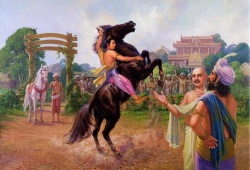Difference between revisions of "Koliya"
| Line 1: | Line 1: | ||
[[File:0440vn.jpg|thumb|250px|]] | [[File:0440vn.jpg|thumb|250px|]] | ||
<poem> | <poem> | ||
| − | The [[Koliyas]]/[[Kolis]] were [[Kshatriya]] of the Adicca ({{Wiki|Iksvaku}}) {{Wiki|clan}} of the {{Wiki|Solar Dynasty}} during the time of [[Gautama]] [[Buddha]]. They have claimed [[Kshatriya]] status themselves. Other than the [[Sakyans]], they had no status equals in their region, and therefore, members of these two royal families married only among themselves. Both {{Wiki|clans}} were very proud of the purity of their royal blood and had practiced this [[tradition]] of inter-marriage since ancient times. For example, [[Suddhodana]]'s paternal aunt was married to the [[Koliyan]] ruler [[Anjana]]. Their daughters, [[Mahamaya]] and [[Mahapajapati Gotami]], were married to [[Suddhodana]], the chief of the [[Sakyans]]. Similarly, [[Yashodhara]], daughter of [[Suppabuddha]], who was Anjana’s son, was married to the [[Sakyan]] {{Wiki|prince}}, [[Gautama]] [[Buddha]]. Thus, the two royal families were related by marriage bonds between maternal and paternal cousins since ancient times.In spite of such close blood-ties, there would be occasional rifts between the two royal families, which sometimes turned into open hostility. | + | The [[Koliyas]]/[[Kolis]] were [[Kshatriya]] of the Adicca ({{Wiki|Iksvaku}}) {{Wiki|clan}} of the {{Wiki|Solar Dynasty}} during the [[time]] of [[Gautama]] [[Buddha]]. They have claimed [[Kshatriya]] status themselves. Other than the [[Sakyans]], they had no status equals in their region, and therefore, members of these two royal families married only among themselves. Both {{Wiki|clans}} were very proud of the [[purity]] of their royal blood and had practiced this [[tradition]] of inter-marriage since ancient times. For [[example]], [[Suddhodana]]'s paternal aunt was married to the [[Koliyan]] ruler [[Anjana]]. Their daughters, [[Mahamaya]] and [[Mahapajapati Gotami]], were married to [[Suddhodana]], the chief of the [[Sakyans]]. Similarly, [[Yashodhara]], daughter of [[Suppabuddha]], who was Anjana’s son, was married to the [[Sakyan]] {{Wiki|prince}}, [[Gautama]] [[Buddha]]. [[Thus]], the two royal families were related by [[marriage]] bonds between maternal and paternal cousins since ancient times.In [[spite]] of such close blood-ties, there would be occasional rifts between the two royal families, which sometimes turned into open [[hostility]]. |
[[Yashodhara]]([[Koliyan]] {{Wiki|Princess}}) and [[Rahula]] with [[Buddha]], Ajanta. | [[Yashodhara]]([[Koliyan]] {{Wiki|Princess}}) and [[Rahula]] with [[Buddha]], Ajanta. | ||
History | History | ||
Revision as of 02:50, 4 September 2013
The Koliyas/Kolis were Kshatriya of the Adicca (Iksvaku) clan of the Solar Dynasty during the time of Gautama Buddha. They have claimed Kshatriya status themselves. Other than the Sakyans, they had no status equals in their region, and therefore, members of these two royal families married only among themselves. Both clans were very proud of the purity of their royal blood and had practiced this tradition of inter-marriage since ancient times. For example, Suddhodana's paternal aunt was married to the Koliyan ruler Anjana. Their daughters, Mahamaya and Mahapajapati Gotami, were married to Suddhodana, the chief of the Sakyans. Similarly, Yashodhara, daughter of Suppabuddha, who was Anjana’s son, was married to the Sakyan prince, Gautama Buddha. Thus, the two royal families were related by marriage bonds between maternal and paternal cousins since ancient times.In spite of such close blood-ties, there would be occasional rifts between the two royal families, which sometimes turned into open hostility.
Yashodhara(Koliyan Princess) and Rahula with Buddha, Ajanta.
History
The Sakyan and Koliyan ruled on opposite banks of the Rohni river(Rupendehi District of Lumbini,Nepal) Their members were called rajas and their chief was the maharaja. They had autonomy over all domestic administrative matters. However, they were not fully independent states like Vaishali (ancient city) Vesali because both were vassal states of the neighbouring kingdom of Kosala.
The Koliya owned two chief settlements, at Ramagama and at Devadaha.
